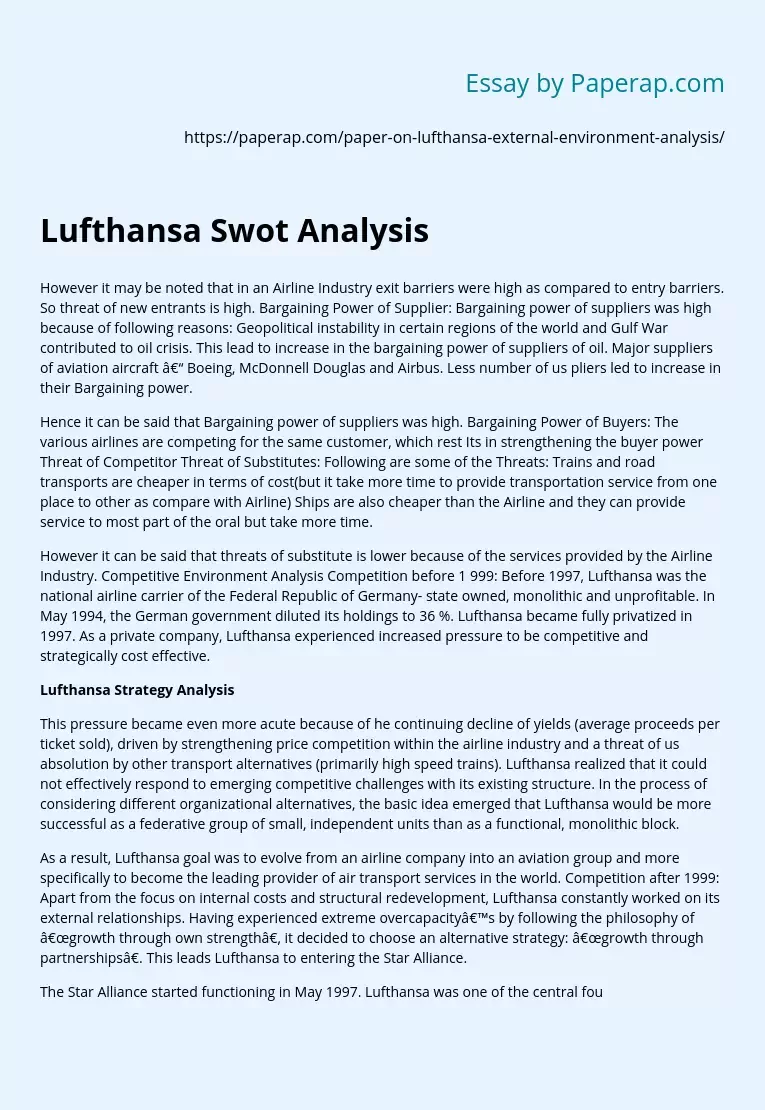Lufthansa Swot Analysis
However it may be noted that in an Airline Industry exit barriers were high as compared to entry barriers. So threat of new entrants is high. Bargaining Power of Supplier: Bargaining power of suppliers was high because of following reasons: Geopolitical instability in certain regions of the world and Gulf War contributed to oil crisis. This lead to increase in the bargaining power of suppliers of oil. Major suppliers of aviation aircraft – Boeing, McDonnell Douglas and Airbus. Less number of us pliers led to increase in their Bargaining power.
Hence it can be said that Bargaining power of suppliers was high. Bargaining Power of Buyers: The various airlines are competing for the same customer, which rest Its in strengthening the buyer power Threat of Competitor Threat of Substitutes: Following are some of the Threats: Trains and road transports are cheaper in terms of cost(but it take more time to provide transportation service from one place to other as compare with Airline) Ships are also cheaper than the Airline and they can provide service to most part of the oral but take more time.
However it can be said that threats of substitute is lower because of the services provided by the Airline Industry. Competitive Environment Analysis Competition before 1 999: Before 1997, Lufthansa was the national airline carrier of the Federal Republic of Germany- state owned, monolithic and unprofitable. In May 1994, the German government diluted its holdings to 36 %. Lufthansa became fully privatized in 1997. As a private company, Lufthansa experienced increased pressure to be competitive and strategically cost effective.
Lufthansa Strategy Analysis
This pressure became even more acute because of he continuing decline of yields (average proceeds per ticket sold), driven by strengthening price competition within the airline industry and a threat of us absolution by other transport alternatives (primarily high speed trains). Lufthansa realized that it could not effectively respond to emerging competitive challenges with its existing structure. In the process of considering different organizational alternatives, the basic idea emerged that Lufthansa would be more successful as a federative group of small, independent units than as a functional, monolithic block.
As a result, Lufthansa goal was to evolve from an airline company into an aviation group and more specifically to become the leading provider of air transport services in the world. Competition after 1999: Apart from the focus on internal costs and structural redevelopment, Lufthansa constantly worked on its external relationships. Having experienced extreme overcapacity’s by following the philosophy of “growth through own strength”, it decided to choose an alternative strategy: “growth through partnerships”. This leads Lufthansa to entering the Star Alliance.
The Star Alliance started functioning in May 1997. Lufthansa was one of the central founding members of the Star Alliance-the most comprehensive, and probably the most competitive airline network in the world. By 2003, the number of members of the Star Alliance had grown to 14 members operating from 894 destinations in 129 countries. By 2001, three other global alliances had emerged: Enroll, World-wide Reliability, and Sky Team (comparison of all four alliances is shown below in the table). Strategically, these developments were of vital importance. With the launch of
Enroll in Feb., 1999 competition in the airline industry had taken on a new dimension. The economic structure of the airline industry started moving from competition between airlines to competition between networks. In consequence, airline networks were striving to intensify integration and common alliance strategies. In this regard, the biggest challenge Star Alliance was facing in 1 999 was to sustain its leading position and to expand market leadership through integrated network management in a new phase of intensifying competition among the rival networks.
Alliances in Comparison July 2001) In 2003, another competition faced by Lufthansa is by ‘low-cost airlines’. The growth of ‘low cost airlines’ structure and business model called into question the traditional model for an airline company. One possible answer was strong, internal segmentation, which would enable Lufthansa to offer service to the low-cost market so as to be able to defend its market share against airlines such as Ryan Air, easy Jet, and others. On the other hand, it would be necessary to pinpoint one focus in order to fully exploit Lufthansa economies of scale and cost efficiencies over the other cheap airline carriers.
Lufthansa Swot Analysis. (2019, Dec 05). Retrieved from https://paperap.com/paper-on-lufthansa-external-environment-analysis/

